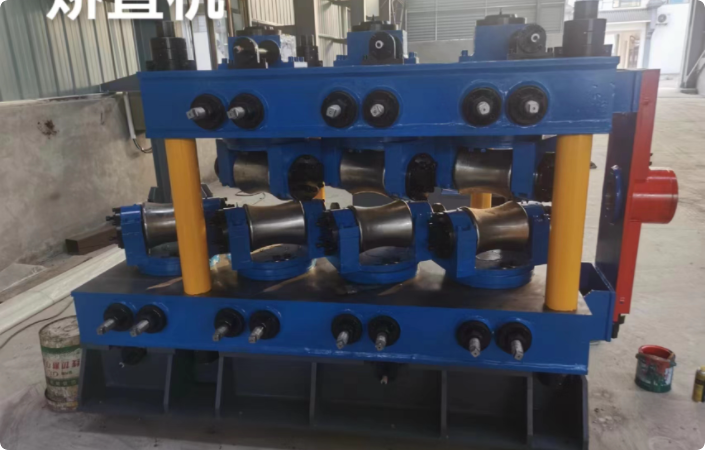steel plate straightening machine
Understanding Steel Plate Straightening Machines
Steel plates are fundamental components used in various industries, from construction to manufacturing, and ensuring they are free from warps and bends is crucial for optimal performance. One of the most effective tools for achieving this is the steel plate straightening machine. This article delves into the function, types, and importance of these machines in industrial applications.
The Function of Steel Plate Straightening Machines
Steel plate straightening machines are specialized equipment designed to correct the geometry of steel plates that have become distorted during manufacturing, transport, or other operational processes. These machines work on the principle of applying controlled pressure and force to the plates to bring them back to their intended flat shape. This correction is vital as even slight deviations can lead to significant problems during fabrication or assembly, potentially compromising the structural integrity of the final product.
The straightening process typically involves several steps. Initially, the operator places the warped plate into the machine, aligning it carefully. The machine then uses hydraulic or mechanical systems to apply pressure at specific points along the plate, gradually forcing it into a more uniform shape. Depending on the level of distortion, this may require multiple passes through the machine, each progressively straightening the material.
Types of Steel Plate Straightening Machines
There are several types of steel plate straightening machines, each designed for specific applications and levels of distortion.
1. Mechanical Straighteners These machines use mechanical leverage and are suitable for lighter plates. They are often simpler in design and easier to operate, making them ideal for smaller operations or workshops.
2. Hydraulic Straighteners More commonly used in larger industrial settings, hydraulic straightening machines utilize hydraulic systems to exert force. They can handle heavier and thicker plates and are capable of addressing more severe warping. Their ability to apply power evenly across the surface makes them highly effective for complex shapes.
3. Roller Straighteners These machines consist of multiple rollers that engage with the steel plate. As the plate passes through, the rollers exert varying degrees of pressure, which gradually straightens the material. Roller straighteners are efficient and can be adjusted to suit different plate sizes and thicknesses.
steel plate straightening machine

4. Flattener Machines While similar to straightening machines, flatteners are specifically designed to achieve a flat surface rather than merely correcting geometric distortions. They are particularly useful for preparing sheets for further processing, such as welding or cutting.
Importance of Steel Plate Straightening Machines
The significance of steel plate straightening machines cannot be overstated. A straightened steel plate is essential for a multitude of reasons
- Quality Assurance In industries where strict specifications are required, straightened plates ensure that all materials meet quality control standards. This is critical in sectors such as aerospace, automotive, and construction, where even minor defects can lead to catastrophic failures.
- Improved Fabrication Straightened plates are easier to work with, leading to more accurate cutting, welding, and assembling. This efficiency not only saves time but also reduces material waste.
- Enhanced Structural Integrity A straight and uniform plate contributes to the overall strength of the final product. In applications where structural integrity is paramount, such as in bridge construction or heavy machinery fabrication, having properly straightened plates is non-negotiable.
- Cost Efficiency By investing in steel plate straightening machines, manufacturers can reduce the need for rework and scrap, thereby optimizing their production processes and improving profitability.
Conclusion
Steel plate straightening machines play a critical role in ensuring that steel plates maintain their intended specifications and structural qualities. With various types available, these machines cater to a wide range of industrial demands. Investing in high-quality straightening equipment not only enhances product quality but also streamlines manufacturing processes. For industries that rely on precision and reliability, utilising these machines is essential in maintaining competitiveness in a demanding market. As technology advances, the capabilities of straightening machines will likely evolve, leading to even more efficient and effective solutions for managing steel plate distortions.
-
High Frequency Straight Seam Welded Pipe Production Line|BzZhou Xinghua|Precision Welding&EfficiencyNewsJul.30,2025
-
High Frequency Straight Seam Welded Pipe Production Line - BzZhou Xinghua|Precision Engineering&EfficiencyNewsJul.30,2025
-
High-Frequency Straight Seam Welded Pipe Production Line-BzZhou Xinghua Machinery Equipment Manufacturing Co., LTD.NewsJul.30,2025
-
High-Frequency Straight Seam Welded Pipe Production Line-BzZhou Xinghua Machinery Equipment Manufacturing Co., LTD.|Precision Manufacturing, High EfficiencyNewsJul.30,2025
-
High Frequency Straight Seam Welded Pipe Production Line-BzZhou Xinghua Machinery Equipment Manufacturing Co., LTD.|Precision Steel Pipe Manufacturing&Industrial EfficiencyNewsJul.29,2025
-
High-Frequency Straight Seam Welded Pipe Production Line-BzZhou Xinghua Machinery Equipment Manufacturing Co., LTD.|Precision Steel Pipe Manufacturing&Industrial EfficiencyNewsJul.29,2025


